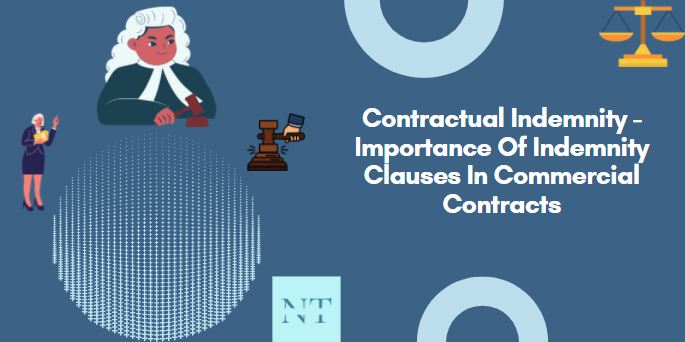Contractual Indemnity: Several articles of the Indian Contract Act of 1872 clarify the nature of the Indemnity Clauses In Commercial Contracts and the promisee’s rights under it. “Security against loss or damages” is what the term indemnity signifies.
To commence, the English law concerning contractual indemnities had arrived at the point of middle age or early maturity by 1872, when the Act was enacted. The basic basis of an indemnity claim has been recognized in common law courts.
Contract of Indemnity is defined under Section 124 of the Indian Contract Act of 1872 as a contract wherein one party pledges to rescue the other from damage caused either by guarantor’s or some other person’s actions.
Table of Contents
Nature of Indemnity Contract
In agreements between tenants and property owners, indemnity provisions are fairly prevalent. Dwellers agree to hold the property owners harmless from any costs or damages incurred as a result of being hurt on the property, whereas the property owners assume responsibility for anything that might be dangerous or bothersome. For example, if a land owner is indemnified from damages if a resident is injured in the property by accident, but if a portion of the property is unsafe and can be quite likely to cause harm and injuries to the occupant, and the owner is informed of the same on a regular basis, a minor indemnity provision will not protect the occupant from filing a lawsuit if the disrepair induced the malfunction.

Essentials Conditions to invoke Contractual Indemnity
As the fact is, there are two parties involved in any typical contract. In an indemnification contract, there has to be more than one party. No one can create a legally binding contract with themselves. These parties must also have the legal ability to contract, that means they cannot be minors or insane. Depending on the scenario, there may be more than two parties.
A promise
One party must offer the conditions to the other party, and then the other party should accept it. Acceptance occurs when a party accepts an offer on the very same terms as the first. It does become a promise if you agree to the deal. The promisor is the one who made a promise, and the promisee is the one who accepted it.
Promise to compensate for losses
The provision in the indemnification contract that “the promisor must make the promise to compensate the promisee’s damages” is crucial.
Whether explicitly stated or implied
An indemnification contract might be expressed or implicit. Under contract law, there are two sorts of contracts: express and implicit. The term “express” refers to a contract that is made orally or in writing, whereas “implied” refers to a contract that is formed as a result of the parties’ actions.
There must be some sort of loss.
The contract of indemnification stipulates that “the damage must be suffered by the promisee.”
Direct of the promisor or other party
The misfortune caused to the promisee ought to be finished by:
1. The conduct of the promisor – The promisor is obligated to pay the misfortune assuming he has accomplished something which thusly made the misfortune to the promisee.
2. Direct from different parties – The promisor is likewise at risk in the agreement of reimbursement assuming the misfortune caused to the promisee is because of some other party moreover. Assuming some other party has accomplished something which caused misfortune to the promisee, the promisor needs to pay for those misfortunes.
Object and consideration that are legal
It’s important to remember that an indemnification contract may only be made for a legal purpose and for a legal price. A contract to do an unlawful conduct that is against public policy cannot be called an indemnification contract. The contract of indemnification must have a legal goal and a legal consideration.
Types of Indemnity
In general, there are two sorts of indemnification: express indemnity and implicit indemnity.
Express Indemnity
It is also referred to as indemnification in writing. All of the indemnity’s terms and conditions are spelled out in detail in the contract. Both parties’ rights and responsibilities are spelled out in detail in the contract. Insurance indemnity contracts, construction projects, and agency contracts are examples of this sort of contract.
Implied Indemnity
It’s the kind of indemnification where the duty is based on the facts and actions of the involved parties. This isn’t a signed agreement. The master-servant relationship is a prime illustration of this form of indemnification. The master is responsible for compensating his servant for any damages incurred while carrying out his orders.
Implied Indemnity Provisions
Adamson vs Jarvis (1872) is a significant case on implied indemnity. The plaintiff in this case was an auctioneer who sold specific commodities on the master’s orders. It was later discovered that the master would not be the legitimate owner of the good, and also the true owner filed a lawsuit against the plaintiff. To recoup the damages, the plaintiff sues the master. The master would be obligated to compensate the auctioneer, according to the court, because it was clear from his actions that he was acting on his orders and that they had an implicit indemnification agreement.
1872 Indian Contract Act, Section 69
According to this provision, if someone pays money on behalf of another person (who is legally obligated to pay), that person is entitled to reimbursement. Forex. If A is the owner of a leased store. A had been out of town when the landlord came to collect the monthly rent, so B paid it on his behalf. A is now responsible for reimbursing B.
The Indian Contract Act, Section 145
It deals with said surety’s rights under a guarantee contract. It specifies that when the surety (guarantor) pays up on the debtor’s behalf, the debtor is obligated to indemnify him by repaying the money. As an example. X took out a bank loan, and Y backed it up with a guarantee. X failed to reimburse the money, and Y was summoned to settle the bank’s debts. Y paid it, but now X is responsible for compensating Y for the damages he suffered.
The Indian Contract Act, Section 222
This clause addresses a principal’s obligation to indemnify his agent for all damages suffered while operating under the power delegated to him.
Other Significant Aspects of Contractual Indemnity
Indemnity Agreements and Legality
One of the types of contracts is an indemnification contract. The principles that apply to contracts in general apply to such contracts as well, thus laws like free permission or consent, the legitimacy of the object, and so on are equally applicable. As with general agreements, permission to an agreement must not be obtained using coercion, fraud, or deception; otherwise, the contract will be voidable at the discretion of the party for whom the consent was obtained in this manner; the same holds true for indemnity contracts. The element or aim of the agreement has to be valid, according to the Contract Act’s requirements.
Suggested Reading:
Rights of Indemnifier
The Indian Contract Act of 1872 excluded indemnifier rights earlier. In the case of Jaswant Singh v. Section Of State, it was determined that the indemnified rights are similar to those of a surety under Section 141, in which the indemnifier is entitled to the benefit of all securities held by the creditor against the principal debtor, whether or not the principal debtor was concerned about them. When a person agrees to reimburse, he will be branded as having succeeded to all of the methods and means whereby the person who was initially compensated would have safeguarded himself from any loss or damage caused; or prepared for recompense for his damages or losses.
Landmark Judgements
Gajanan Moreshwar v.. Moreshwar Madan.
The defendant was permitted to establish a structure on property leased from the city’s municipal administration in the landmark judgement of Gajanan Moreshwar Vs. Moreshwar Madan. The defendant was in debt to the construction material supplier twice, and on both instances, he mortgaged a portion of the land to a third party in exchange for being released from his obligations arising from it. However, he failed to do it anyway, and the defendant was sued for purportedly getting the liabilities dismissed, and Gajanan was sued as an indemnifier.
The courts ruled in this case that the judge in the landmark case of Gajanan Moreshwar vs. Moreshwar Madan made the following observation:
If the party having the indemnity has already been notified that he has incurred an absolute responsibility, he has the right to demand that the other party pay the liability amount. A contract of indemnity is a specific contract in which one party commits to protect the other against loss caused by the promisor’s or any other party’s actions. This is also stated in sections 124 and 125 of the statute.
State Bank of India and others v. Mula Sahkari Sakhar Karkhana Ltd.
A common held principle in another leading case, State Bank of India and others v. Mula Sahakari Sakhar Karkhana Ltd., was that a bank guarantee is a different, distinct, and independent contract here between bank and defendants, but that there is a difference among a contract of guarantee and a contractual indemnity, wherein a party happens to agree to indemnify another with regards to all assertions, damages, losses, actions, and damages resulting out of suit.
Osman Jamal and children ltd v. Gopal Purushottam
In the main instance of Osman Jamal and children ltd v. Gopal Purushottam, it was guided by CJ Kennedy, that the authority toward having this perspective in the court of Equity to repay just doesn’t simply mean to repay in regard to the paid cash, yet additionally to save in regard from misfortune all risk against which the reimbursement stands.
Conclusion
Indemnity is a legal relief from the consequences or responsibilities of a certain course of conduct. Simply put, indemnification requires one party to compensate others if certain expenditures specified in the indemnity contract are incurred by a third party. Automobile rental firms, for example, stipulate that the person renting the car is responsible for any damage or losses made to the car as a result of the individual’s own reckless or negligent driving, and that he or she must compensate the rental company. Liability concerns can never be solved with a simple indemnification clause. Those who attempt to avoid culpability or seek relief from liability for their activities will find the law to be unfavourable to them.
References:
- Singh, Avtar. Law of Contract. Eastern Book Company, 1994.
- Sukhramani, Pulkit. “Indemnity and Damages.” SSRN Electronic Journal, 2012. https://doi.org/10.2139/ssrn.2020687.
- “The Scope of the Indemnity.” In Contractual Indemnities. Hart Publishing, n.d. Accessed 15 January 2022. https://doi.org/10.5040/9781474202084.ch-004.
- Courtney, Wayne. Contractual Indemnities. Bloomsbury Publishing Plc, 2016.
| Go To Sundarban News Today’s Home Page | Click Here |
| Wikipedia Article on Contractual Indemnity | Click Here |
| Article Category | Legal Guide |
